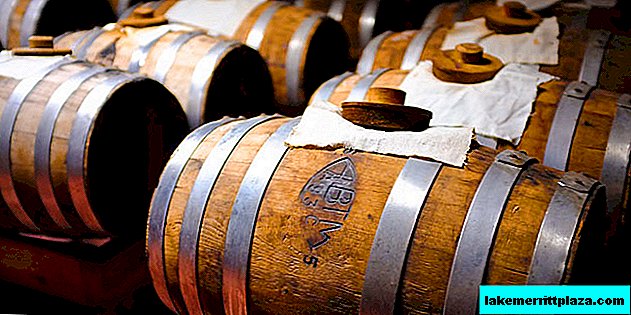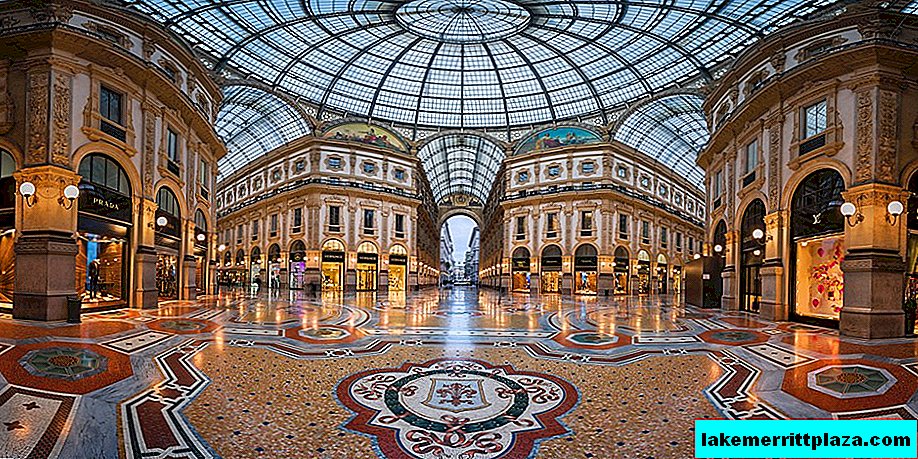Continuing the theme of the first part of the post Attractions of Perugia, today we will talk about the most interesting places in the ancient city, remembering the times of the Etruscans and Romans. But before we go directly to the sights, we must first say a few words about the Square on November 4.
Modern Square on November 4 in Perugia is a favorite vacation spot for young people. Exhibitions and festivals often take place on its pavement, and street musicians perform their hits on the steps of the Priori Palace. Toward evening in the Square, you won’t bump into it: they sing, have fun, play guitars and ... just enjoy life.
No. 4. Cathedral of San Lorenzo (Cathedral di San Lorenzo)
In the northern part of the square on November 4, facing it with its side facade, contrary to all architectural traditions, it majestically rises Cathedral of San Lorenzo.
The construction of the Cathedral began in the middle of the XIV century and lasted more than 2 hundred years, and its main facade of white and pink marble was also completed in the XVIII century. However, some details of the Cathedral of San Lorenzo remained incomplete.
The main relic of the temple is a simple onyx wedding ring, which, according to legend, belonged to the Virgin Mary. It is stored under fourteen castles in the relic of the Cathedral of San Lorenzo - the chapel of the Holy Ring. On public display, the sacred relic is exhibited only twice a year: in September and July 31 - on the feast of the remission of sins.

The main relic of the Cathedral of San Lorenzo is the engagement ring of the Virgin Mary
In the altar of the Cathedral of San Lorenzo, the symbol of the city is stored - the Perugia Banner. It is believed that the painting, created by Berto Giovanni in 1526, protected the townspeople from the plague that was raging at that time.
Particularly noteworthy are the altar painting "Descent from the Cross" by Barocci and the image of the Madonna del Grazie - the creation of the artist Gian Niccolo di Paolo. Numerous pilgrims of the Cathedral of San Lorenzo believe that the icon of the Mother of God has extraordinary miraculous power.
No. 3. The Palazzo dei Priori
The Priori Palace in Perugia (City Council), also located on November 4, is another magnificent monument of the Middle Ages. Initially, the building of the Palazzo dei Priori was built for the city authorities, but today the museums of Umbria are located on its premises.
The history of the building goes deep into the XIII - XVI centuries, during which it was repeatedly modified and rebuilt.
Main facade Palazzo dei Priori goes to the pedestrian boulevard - Corso Vannuchi, and its butt - to the great Fountain of Maggiore. It is here that above the portal overlooking the square, bronze griffin and helphian lion are placed - the eternal symbols of Perugia.
From the consoles, where symbolic sculptures proudly sit, fragments of chains hang to which in the old days the keys to the city gates of Siena were attached - a reminder of the victory of the Perugians in 1358.

Priorov Palace was built for the city authorities
The roof of the Prior Palace is decorated with square battlements, which are a symbol of the independence of the city. In 1610, on the orders of the Pope of Rome, who considered Perugia his own estate, the battlements were demolished, but after 250 years the freedom-loving townspeople restored them again. However, this happened already when the city gained independence, becoming part of the united Italy.
On the third floor of the Palazzo is located National Gallery of Umbria. On the second - the Hall of Notaries (Sala dei Notari), painted with frescoes of Cavallini. On the first floor of the Palazzo dei Priori, you can visit the Bankers Guild (Collegio del Cambio), which in ancient times served as a kind of money exchange center.
The rooms of the Merchants Guild (Collegio della Mercanzia) are decorated with rich paintings of Perugino and his students, as well as magnificent wood inlays made in the 15th century.
No. 2. National Gallery of Umbria (Galleria Nazionale dell'Umbria)
Located on 4 thousand square meters of the third floor of the Palace of Priorov, the National Gallery of Umbria is one of the largest art museums in Italy. Its priceless collection consists of three thousand works of art, among which are paintings and sculptures of Italian masters of the 13th - 19th centuries.
Art exhibits in the Gallery of Umbria are placed in chronological order, and the most valuable are paintings dated to the XIV-XVI centuries. Among them are works by masters of the Umbrian school (Pinturicchio, Piero della Francesca and others) and painters from other art schools in Italy (Duccio di Buoninsenya, Pietro Perugino, Giuseppe Cesari, Gentile da Fabriano, Fra Angelico and others). Among the sculptural collection are many works by Niccolo and Giovanni Pisano.

In the Gallery of Umbria, more than 3 thousand works of art
A special attention at the National Gallery of Umbria is also deserved by the collection of decorative and applied art, represented by ceramic products, ivory crafts, jewelry, tapestries, gold and church utensils.
The foundation of the future collection of the Umbrian National Gallery was laid in the 16th century by the Academy of Painting of Perugia, which was originally located in the Monte Morciano Nuovo Monastery.
The Umbrian Museum owes its present wealth of exhibits to the expropriation of church property, which happened in Italy twice. For the first time during Napoleon’s time, the most valuable works of art were taken from Italian churches and monasteries. The second wave of seizure occurred in 1871 after the unification of Italy. This time, her main goal was to weaken church authority.
No. 1. Fontana Maggiore
In the heart of the square on November 4 is one of the most beautiful medieval fountains in Italy - the Fountain of Maggiore (dosl. Big Fountain).
Maggiore Fountain in Perugia consists of two pools made of white and pink marble and decorated with sculptures and bas-reliefs on biblical, mythological and secular subjects. Above the pools is a bronze bowl.
The main squares of medieval Italian cities, as a rule, were always decorated with a central decorative element - a fountain. However, in Perugia, the opposite was true: the area was created around the Fontana Maggiore. As early as the 13th century, ancient wells were the source of drinking water in the city. In 1254-1276, the city authorities built an extensive system of aqueducts designed to provide the city with fresh water on Mount Pacciano, which is only a few kilometers from Perugia. Then it was decided to build a large fountain, the construction of which in 1275 was entrusted to Nicolo and Giovanni Pisano.

Maggiore Fountain decorated with sculptures and bas-reliefs on biblical themes
In 1278, the Fountain of Maggiore, decorated with numerous statues and reliefs, appeared in all its splendor. A law was even passed prohibiting washing the hands, watering animals, and filling wine barrels with water from the fountain in the fountain ...
On this list of what is worth seeing in Perugia does not end there. Having enough time and armed with a guidebook, you can visit the churches: San Angelo, San Ercolano and San Severo, erected on the site of the pagan temple of the Sun and decorated with frescoes of Perugino and Raphael. Or see the 35-meter Well of the Etruscans. You can also go down to the lower part of the city to the papal fortress Rocca Paolina to admire the terraced gardens of Carducci. Or just take a stroll through the medieval streets winding around Corso Vannucci, at the end of which from the observation platforms a magnificent panorama of the Tiber Valley opens ...
P.S. Photos by: Ma Rui, Boobooo, 3blindmice, Maurizio Zanetti, Andy Norris UK.








